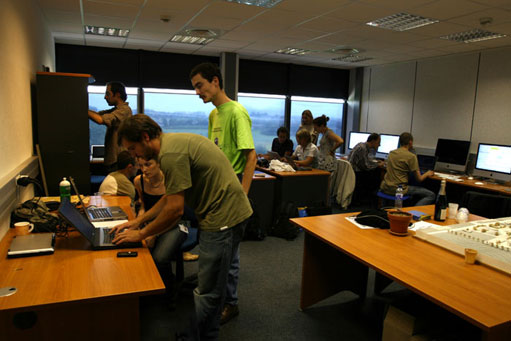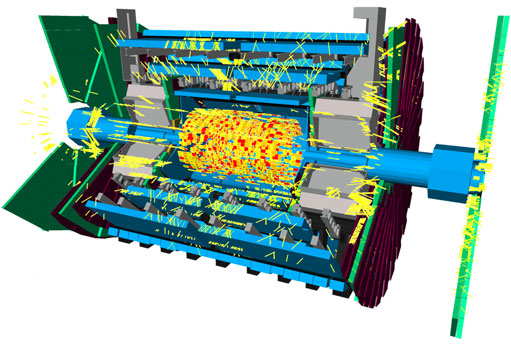
ATLAS e-News
23 February 2011
Data quality latest
6 October 2008

The data quality control room, above the ATLAS control room, courtesy of Doris Burckhart
Two weeks ago, in a special issue of ATLAS e-news, we brought you a round-up of first beam activity, as seen through the eyes of the sub-detector groups. That week’s gallery featured images of jubilant collaborators, snapped as they saw the first pictures of beam splash events projected onto the Control Room walls. But, had it not been for the team of data quality (DQ) experts beavering away two floors above their heads and at special DQ stations in the CR, they would have been clueless as to what was happening within their detectors.
“We’ve set up a chain so that the 2D and 3D event display pictures are both on-line continuously in the Control Room,” says DQ Co-Coordinator, Michael Hauschild. “It works in real time, so when we display an event: Blump-Pffffff,” he describes, gesturing with his hands like a firework, “it flashes up on the screens immediately.”

One of the memorable 3D “beam splash” images pulled out by the DQ team on September 10th
On September 10th, a crowd of 20 data reconstruction and event display experts were stationed in the DQ satellite control room at Point 1, maintaining the CR displays and sifting through the first-beam pictures to pick out those which looked the most appealing, before feeding them through to the CR, collaboration, press, and public. In the case of the 3D images, this also involved selecting the viewing angle and zoom level that best showed off the detector in action.
“It’s clear, it was an exceptional day, so we needed an exceptional number of people in the room,” says Michael, making the comparison with normal working practice for data-taking, which will involve just one shifter and perhaps one or two detector experts on hand. On the day of the first beam though, experts from every facet of the detector were present. “They were looking through the data as quickly as possible,” says Michael, busying themselves with “scanning, reconstruction, and checking: Are the data looking OK?”
Of course, pulling out the prettiest pictures is not something the DQ shifters will be concerning themselves with in the long-term. During the initial phase of beam, the person on duty will be focussed primarily on keeping the event displays running, and monitoring DQ infrastructure such as web pages and data distribution channels.
Histograms produced by the ATLAS software are checked automatically against pre-defined algorithms, from the simple: is this histogram filled? to complex statistical comparisons. The results are flagged using a red/amber/green traffic light system to tell the physics analyst, wherever they may be in the world, whether the data they’re looking at is useable or not.
“But not everything can go automatic at the start, because we don’t know what is a good histogram yet,” explains Michael. When data taking begins, the DQ experts will initially check some of the histograms manually, and have the option to override the automatic flags, training the system to be more effective.
Once the detector is in full flight, the DQ shifters – one on-line and one off-line at any one time – will be responsible for looking globally at the correlation of the individual sub-systems, ensuring that the patchwork picture of fragmented particle tracks can be stitched together to give a unified overview.
“We’re working on the timing of the detector, using cosmics, right now,” says Michael, “because [for data taking] the triggers for each of the detectors have to be on the same spot, at the same time, for the same bunch crossing.” Once the triggers have been synchronised – using cosmics and future collimator events – they will calibrate for time delays in the transmission of actual data signals, caused by the differing lengths of cable between the sub-detectors and the front-end electronics. By this time, the whole detector should be timed to perfection and performing like a well-trained orchestra, and there will only be one thing left to wait for: collisions.

Ceri PerkinsATLAS e-News |